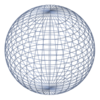Genus (mathematics)
In mathematics, genus (plural genera) has a few different, but closely related, meanings:
Topology
Orientable surface
The genus of a connected, orientable surface is an integer representing the maximum number of cuttings along closed simple curves without rendering the resultant manifold disconnected. It is equal to the number of handles on it. Alternatively, it can be defined in terms of the Euler characteristic χ, via the relationship χ = 2 − 2g for closed surfaces, where g is the genus. For surfaces with b boundary components, the equation reads χ = 2 − 2g − b.
For instance:
- The sphere S2 and a disc both have genus zero.
- A torus has genus one, as does the surface of a coffee mug with a handle. This is the source of the joke that "a topologist is someone who can't tell their donut apart from their coffee mug."
An explicit construction of surfaces of genus g is given in the article on the fundamental polygon.
- Genus of orientable surfaces
-
genus 0
-
genus 1
-
genus 2
-
genus 3
Non-orientable surfaces
The non-orientable genus, demigenus, or Euler genus of a connected, non-orientable closed surface is a positive integer representing the number of cross-caps attached to a sphere. Alternatively, it can be defined for a closed surface in terms of the Euler characteristic χ, via the relationship χ = 2 − k, where k is the non-orientable genus.
For instance:
- A projective plane has non-orientable genus one.
- A Klein bottle has non-orientable genus two.
Knot
The genus of a knot K is defined as the minimal genus of all Seifert surfaces for K. A Seifert surface of a knot is however a manifold with boundary the boundary being the knot, i.e. homeomorphic to the unit circle. The genus of such a surface is defined to be the genus of the two-manifold, which is obtained by gluing the unit disk along the boundary.
Handlebody
The genus of a 3-dimensional handlebody is an integer representing the maximum number of cuttings along embedded disks without rendering the resultant manifold disconnected. It is equal to the number of handles on it.
For instance:
- A ball has genus zero.
- A solid torus has genus one.
Graph theory
The genus of a graph is the minimal integer n such that the graph can be drawn without crossing itself on a sphere with n handles (i.e. an oriented surface of genus n). Thus, a planar graph has genus 0, because it can be drawn on a sphere without self-crossing.
The non-orientable genus of a graph is the minimal integer n such that the graph can be drawn without crossing itself on a sphere with n cross-caps (i.e. a non-orientable surface of (non-orientable) genus n).
In topological graph theory there are several definitions of the genus of a group. Arthur T. White introduced the following concept. The genus of a group is the minimum genus of any of (connected, undirected) Cayley graphs for .
The graph genus problem is NP-complete (Thomassen 1989).
Algebraic geometry
There are two related definitions of genus of any projective algebraic scheme X: the arithmetic genus and the geometric genus. When X is a algebraic curve with field of definition the complex numbers, and if X has no singular points, then both of these definitions agree and coincide with the topological definition applied to the Riemann surface of X (its manifold of complex points). The definition of elliptic curve from algebraic geometry is non-singular curve of genus 1 with a given point on it.






